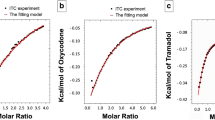Abstract
The molecular encapsulation of two tricyclic antidepressants (TCA) drugs, amitriptyline and imipramine, by a glycosidic receptor, 6-hydroxypropyl-β-cyclodextrin (HPBCD), has been carried out in water solution by means of conductometric studies at different temperatures ranging from 15 °C to 45 °C. Conductivity measurements of aqueous solutions of the drug were performed: (i) in the absence of HPBCD, as a function of drug concentration; and (ii) in the presence of HPBCD, as a function of HPBCD concentration. Both drugs, amitriptyline and imipramine, form inclusion complexes characterized by a 1:1 stoichiometry and an association constant (\(K_{\rm HPBCD:TCAH^+}\)) in the range of 500–1200 M−1. The ionic molar conductivities at infinite dilution of the free (\(\lambda_{\rm TCAH^+}^0\)) and complexed (\(\lambda_{\rm HPBCD:TCAH^+}^0\)) drugs have been calculated from these conductivity data as well. From the dependency of the association constant on temperature, changes on the enthalpy, ΔH 0, entropy, ΔS 0, and heat capacity at constant pressure, \(\Delta C_{\rm p}^{0}\) , have been determined. This thermodynamic information, which reveals that the complexes formed by HPBCD and the antidepressant drugs, AMYTPH+ and IPRH+, are enthalpy driven at T ≥ 25 °C but entropy driven at T < 25 °C, points to the contribution of van der Waals interactions, hydrophobic effect and solvent reorganization, as the main driven forces promoting the interaction. The analysis of these association processes was also used to elucidate the potential viability of using HPBCD as a vector of these antidepressant drugs.





Similar content being viewed by others
References
Bowman, W.C., Rand, M.J.: Textbook of Pharmacology. Blackwell Sci. Pubs., Cambridge (1990)
Hall, C.M., Nugent, R.A.: Encyclopedia of Chemical Technology, vol 2. John Wiley & Sons, New York (1992)
Atwood, J.L., Davies, J.E.D., MacNicol, D.D., Vögtle, F.: Comprehensive Supramolecular Chemistry. Pergamon, Oxford (1996)
Connors, K.A.: The stability of cyclodextin complexes in solution. Chem. Rev. 97:1325–1357 (1997)
D’Souza, V.T., Lipkowitz, K.B.: Cyclodextrins. Chem. Rev. 98:1741 (1998)
Thompson, D.O.: Cyclodextrin-enabling excipients: their present and future use in pharmaceuticals. Crit. Rev. Therap. Drug Carrier Syst. 14:1–104 (1997)
Duchene, D., Wouessidjewe, D., Ponchel, G.: Cyclodextrins and carrier systems. J. Control.Release 62: 263–268 (1999)
Junquera, E., Aicart, E.: A fully computerized technique to measure conductivity in liquid mixtures. Rev. Sci. Instrum. 65: 2672–2674 (1994)
Deranleau, D.A.: Theory of the measurement of weak molecular complexes. I. General considerations. J. Am. Chem. Soc. 91:4044–4049 (1969)
Junquera, E., Aicart, E.: Potentiometric study of the encapsulation of ketoprophen by hydroxypropyl-β-cyclodextrin. Temperature, solvent, and salt effects. J. Phys. Chem. B 101:7163–7171 (1997)
Robinson, R.A., Stokes, R.H.: Electrolyte Solutions. Butterworth, London (1965)
Tinner, U.: Electrodes in Potentiometry. Metrohm, Herisau (1989)
Brüll, L.: Gazz. Chim. Ital. 64: 624 (1934)
Junquera, E., Martin-Pastor, M., Aicart, E.: Molecular encapsulation of flurbiprophen and/or ibuprophen by hydroxypropyl-β-cyclodextrin in aqueous solution. Potentiometric and molecular modeling studies. J. Org. Chem. 63:4349–4358 (1998)
Rajewski, R.A., Stella, V.J.: Pharmaceutical applications of cyclodextrins.2. In vivo drug delivery. J. Pharm. Sci. 85:1142–1169 (1996)
Junquera, E., Peña, L., Aicart, E.: Conductivity studies of the molecular encapsulation of sodium perfluorooctanoate by β-cyclodextrin. J. Incl. Phenom. Mol. Recogn. Chem. 24: 233–239(1996)
Junquera, E., Peña, L., Aicart, E.: Binding of sodium salicylate by β-cyclodextrin or 2,6-di-O-methyl-β-cyclodextrin in aqueous solution. J. Pharm. Sci. 87: 86–90 (1998)
Junquera, E., Romero, J.C., Aicart, E.: Behavior of tricyclic antidepressants in aqueous solution: self-aggregation and association with β-cyclodextrin. Langmuir 17:1826–1832 (2001)
Junquera, E., Peña, L., Aicart, E.: A conductimetric study of the interaction of β-cyclodextrin or hydroxypropyl-β-cyclodextrin with dodecyltrimethylammonium bromide in water solution. Langmuir 11: 4685–4690 (1995)
Peña, L., Junquera, E., Aicart, E.: Ultrasonic study of the molecular encapsulation and the micellization processes of dodecylethyldimethylammonium bromide-water solutions in the presence of β-cyclodextrin or 2,6-di-O-methyl-β-cyclodextrin. J. Solution Chem. 24: 1075–1091 (1995)
Junquera, E., Peña, L., Aicart, E.: Micellar behavior of the aqueous solutions of dodecylethyldimethylammonium bromide.A characterization study in the presence and abscence of hydroxypropyl-β-cyclodextrin. Langmuir 13:219–224 (1997)
Sigurskjold, B.W., Bundle, D.R.: Thermodynamics of oligosaccharide to a monoclonal antibodi specific for a salmonella O-antigen point hydrophobic interactions in the binding site. J. Biol. Chem. 267: 8371–8376 (1992)
Bains, G., Lee, R.T., Lee, Y.C., Freire, E.: Microcalorimetric study of wheat germ agglutinin binding to N-acetylglucosamine and its oligomers. Biochemistry 31:12624–12628 (1992)
Rekharsky, M.V., Schwarz, F.P., Tewari, Y.B., Goldberg, R.N., Tanaka, M., Yamashoji, Y.: Thermodynamic and NMR study of the interactions of cyclodextrins with cyclohexane derivatives. J. Phys. Chem. 98: 4098–4103 (1994)
Harrison, J.C., Eftink, M.R.: Cyclodextrin-adamantanecarboxylate inclusion complexes: a model system for the hydrophobic effect. Biopolymers 21: 1153–1166 (1982)
Diederich, F., Smithrud, D.B., Sanford, E.M., Wyman, T.B., Ferguson, S.B., Carcanague, D.R., Chao, I., Houk, K.N.: Solvent effects in molecular recognition. Acta Chem. Scand. 46: 205–215 (1992)
Smithrud, D.B., Wyman, T.B., Diederich, F.: Enthalpically driven cyclophane-arene inclusion complexation: solvent-dependent calorimetric studies. J. Am. Chem. Soc. 113: 5420–5426 (1991)
Stauffer, D.A., Barrans, R.E., Dougherty, D.A.: Concerning the thermodynamics of molecular recognition in aqueous and organic media. Evidence for significant heat capacity effects. J. Org. Chem. 55: 2762–2767 (1990)
Chervenak, M.C., Toone, E.J.: A direct measure of the contribution of solvent reorganization to the enthalpy of ligand binding. J. Am. Chem. Soc. 116: 10533–10539 (1994)
Toone, E.J.: Structure and energetics of protein-carbohydrate complexes. Curr. Opin. Struct. Biol. 4: 719–728 (1994)
Hayashi, T., Miyahara, T., Koide, N., Kato, Y., Masuda, H., Ogoshi, H.: Molecular recognition of ubiquinone analogues. Specific interaction between quinone and functional porphyrin via multiple hydrogen bonds. J. Am. Chem. Soc. 119: 7281–7290 (1997)
Hobza, P., Zahradnik, R.: Intermolecular Complexes. Elsevier, New York (1988)
Acknowledgements
The authors thank the Spanish Ministry of Education, Project No. BQU2005–1106, and to the Comunidad Autónoma of Madrid, Project UCM-CAM (ref. 910447) for supporting this research.
Author information
Authors and Affiliations
Corresponding author
Rights and permissions
About this article
Cite this article
Cano, J., Rodriguez, A., Aicart, E. et al. Temperature effect on the complex formation between tricyclic antidepressant drugs (amitriptyline or imipramine) and hydroxypropyl-β-cyclodextrin in water. J Incl Phenom Macrocycl Chem 59, 279–285 (2007). https://doi.org/10.1007/s10847-007-9328-x
Received:
Accepted:
Published:
Issue Date:
DOI: https://doi.org/10.1007/s10847-007-9328-x




